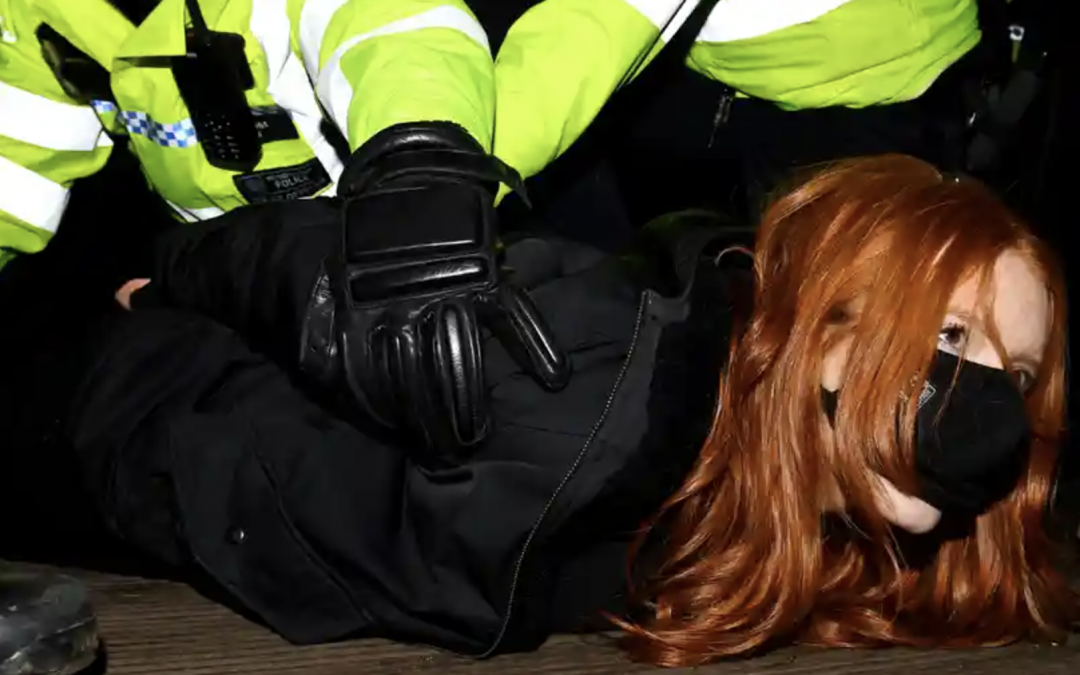Britain prides itself on being a bastion of democracy with the intrinsic right to protest. What few realise is just how fluid the definition of ‘lawful protest’ can be. When peaceful protests threaten big business or those in power, successive British governments have brought in sweeping changes which infringe upon our rights, turning effective nonviolent protest into serious criminal offences. Here’s five examples:
- When Black Lives Matter (BLM) protests swept the UK in 2020 in response to deep rooted institutional racism, one iconic action hit the headlines. A statue to prolific slave trader Edward Colston had long been a source for contention in the city of Bristol, with councilors, MP’s, artists, and the local mayor calling for it’s removal. During a peaceful protest, activists pulled the statue to the ground, before rolling it into the nearby harbour. The incident caused local authorities and institutions across the country to rethink and remove memorials to contentious figures. Local Police Superintendent Andy Bennett said, ‘Whilst I am disappointed that people would damage one of our statues, I do understand why it’s happened, it’s very symbolic.’ The Home Secretary Priti Patel however, labelled it ‘utterly disgraceful’ and proposed new legislation which would carry a ten year prison sentence for damaging a memorial. This is a higher sentence than committing grievous bodily harm, violent disorder, affray, theft, carrying knives, acid or offensive weapons, voyeurism, upskirting and causing death by careless driving.
- In 2020, Extinction Rebellion (XR) blockaded three printing presses owned by Rupert Murdoch’s media empire. Their protest was aimed at highlighting the lack of urgency surrounding climate issues presented in the press, and lasted for one night. As a result, several newspapers had to go a day without releasing a physical edition. The Home Secretary Priti Patel described it as an ‘attack on democracy’, and announced legislation which would make it a specific crime to blockade a newspaper press. Met Police Chief Cressida Dick said, ‘I have been talking publicly and with the government about the potential for change to powers and legislation that would enable the police to deal better with protests, given that the act that we work to is now very old, [dating to] 1986.’
- In 2006, in response to the Stop Huntingdon Animal Cruelty (SHAC) campaign, Tony Blair introduced new legislation under the Serious Organised Crime and Police Act, which made it a crime to ‘interfere with contractual relationships so as to harm animal research organisation’. Acts of low level disobedience against companies linked to animal testing, such as leafleting in a company’s carpark, or blockading their gates now carry up to a five year prison sentence.
- In 1993, in order to disrupt hunt saboteurs and those protesting against new road developments such as Twyford Down, Home Secretary Michael Howard unveiled the Criminal Justice Bill which made trespass on open land a criminal offence rather than a civil one.
- During the miners’ strikes, in 1979 Margaret Thatcher went to war with Britain’s trade unions. Among the actions she took was a ban secondary picketing. This meant that striking miners were unable to extend their pickets to companies who supplied, or otherwise supported the mines they were protesting against.
With every generation, our right to protest is chipped away. Once removed, these rights are rarely returned. Each new wave of protestors find they can do a little less than their parents and what was once deemed ‘just a protest’, becomes easier to frame as an ‘attack on democracy’.
The twisted irony of course is that the attack on democracy is well underway, but by the very institutions who are supposed to protect it.

